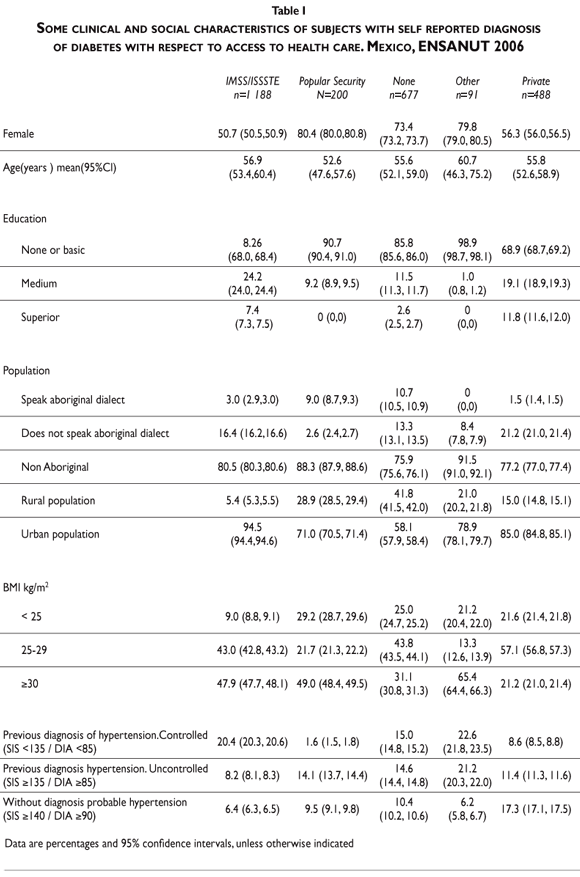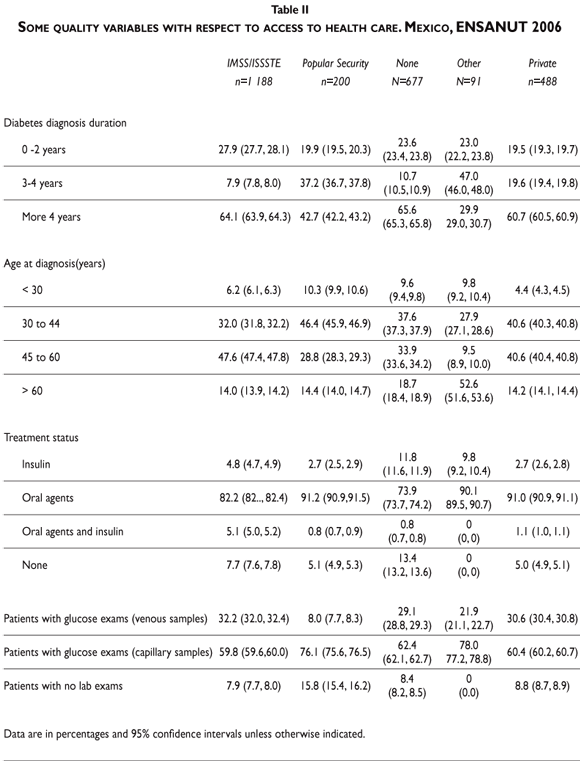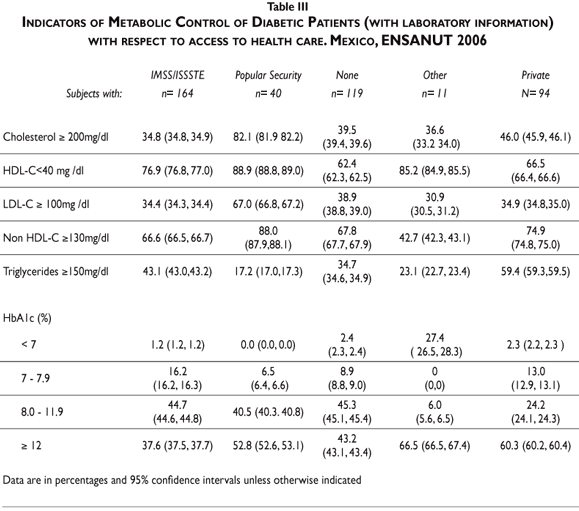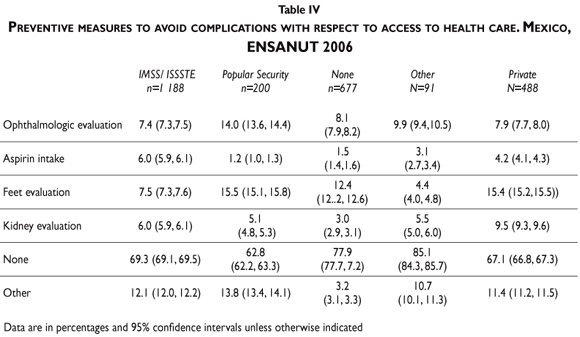Servicios Personalizados
Revista
Articulo
Indicadores
Links relacionados
-
 Similares en
SciELO
Similares en
SciELO
Compartir
Salud Pública de México
versión impresa ISSN 0036-3634
Salud pública Méx vol.52 supl.1 Cuernavaca ene. 2010
ARTÍCULO ORIGINAL
The status of diabetes care in Mexican population: Are we making a difference? Results of the National Health and Nutrition Survey 2006
El cuidado de la diabetes en población mexicana ¿Estamos siguiendo la estrategia correcta? Resultados de la Encuesta Nacional de Salud y Nutrición 2006
Clicerio González-Villalpando, MD, MACP,I,II; Ruy López-Ridaura, MD, DSc,I,II; Julio César Campuzano, MD, DSc,I; María Elena González-Villalpando, MD.II
ICentro de Investigación en Salud Poblacional. Instituto Nacional de Salud Pública. Cuernavaca, Morelos, México
IICentro de Estudios en Diabetes, AC. México, DF, México
ABSTRACT
OBJECTIVE: Examine clinical indicators to evaluate diabetes care in Mexico.
MATERIAL AND METHODS: Diabetics (self reported, with therapy) were examined with standardized questionnaires, anthropometry, glucose, lipids and glycohemoglobin. Data were analyzed statistically.
RESULTS: There were 2 644 patients, 677 cases without access to medical care (73% women), most lived in rural communities and spoke aboriginal dialect. Prevalence of obesity for private access group was 21.2%, for other or non access group was between 31 and 65%. The group without or basic education was most common, 76% of the cases had HDL <40 mg/dl and 36% had hypertriglyceridemia. Only 6.6% of patients had HbA1c <7%. There was no significant difference between HbA1c values observed in the group with or without access. Most patients were treated with oral agents. A significant group was without therapy. Assessments for complications was infrequent.
CONCLUSIONS: Current model for diabetes care in Mexico is inefficacious and a paradigm change is necessary.
Key words: diabetes; care; control; access; Mexico
RESUMEN
OBJETIVO: Examinar indicadores para evaluar la atención de diabetes en México.
MATERIAL Y MÉTODOS: Se examinaron diabéticos (autorreportados, con tratamiento) con cuestionario estandarizado, antropometría, glucosa, lípidos y hemoglobina glucosilada. Los datos se analizaron estadísticamente.
RESULTADOS: De 2 644 casos, 677 no tenían acceso a atención médica (73% mujeres), la mayoría eran de comunidades rurales y hablaban un dialecto indígena. La prevalencia de obesidad en el grupo con acceso privado fue 21,2%; en personas con otro o sin acceso, fue entre 31 y 65%. El grupo sin o con educación básica fue el más común. El 76% de los casos tenían colesterol HDL <40 mg/dl y 36% tenía hipertrigliceridemia. Sólo 6.6% tenían la HbA1c <7%. No hubo diferencias entre valores de HbA1c en el grupo con o sin acceso. La mayoría recibían hipoglucemiantes orales, muchos sin tratamiento. La evaluación de complicaciones fue infrecuente.
CONCLUSIONES: El modelo de atención de diabetes en México es ineficaz y es preciso cambiar de paradigma.
Palabras clave: diabetes; atención; control; acceso; México
The growing pandemic of diabetes and its complications has been recognized as the greatest challenge for all health care systems in the world. Most indicators, strongly point towards a further increment in demand and utilization of healthcare resources, with the consequent significant increase in the already staggering costs associated to the care of these pathologies.1
In Mexico, a particularly ominous scenario is occurring; diabetes prevalence has increased to a worrisome 14.3% of the adult population. Simultaneously, diabetes is the number one cause of death in the country.2-3 This means that despite a very high lethality, the disease is getting more prevalent. Among the possible interpretations of these facts, is that the incidence of diabetes is increasing at such a high rate that, despite the very significant mortality, the prevalence remains increasing. Regardless of the explanation(s) of this serious circumstance, the situation is imposing an enormous strain on the national health care system. Moreover, there is evidence to support that diabetes and its chronic complications, generate the most significant costs of the entire health care expenditure.4 There is a strong need for more information in order to implement strategies to contain the epidemic and handle its consequences by investing wisely in strategies that need to be evaluated constantly.
The therapeutic armamentarium to deal with diabetes and associated risk factors, at the clinical level has increased over the past decades, so its costs. The Mexican health care systems dedicate substantial resources to this matter. However, there are few indicators of the effectiveness of this strategy. The information available alerts about an ineffective performance of the system.5 This finding has been a subject of concern in different countries because in general, the operation of the health care system tends to yield relatively poor outcomes at considerable costs.6
In most situations that explore the efficacy of the system in dealing with diabetes, the attention has been focused in the process of care, not in the outcome of the specific process.7-8 Clearly this approach measures performance in compliance with specific recommendations or guidelines. The behavior displayed by the provider, most likely a physician, is assessed by comparing it, with respect to a specific reference, counting the times in which the "correct" therapeutic maneuver is performed/indicated. This has been called "quality of care". Some of the accepted therapeutic guidelines have been created to facilitate and increase the translation of good evidence based information to the care of the patient. Most of these guidelines are well developed documents that compile evidence based information and translate it, into recommended therapeutic maneuvers. It is very important to keep in mind that the availability of resources at the local clinic modulates the plausibility of a particular recommendation. Hence, it is not enough to have the evidence and with ideal plan, its implementation has to be done realistically in the clinical setting.
We have examined a series of clinical indicators that allows a perspective of the status of the care of patients with diabetes in Mexico. The indicators were selected because it's clinical importance.
Materials and Methods
The design, methods and procedures of the National Health and Nutrition Survey 2006 (ENSANUT 2006) has been described elsewhere.2 Briefly, with a probabilistic multistage stratified cluster sampling design aimed to have a national and state level representative sample, a total of 45 446 adults aged 20 years or more were examined, a questionnaire, blood pressure and anthropometric measurements were included. Blood samples were collected from 30% of a randomly selected adults, most of them (91.3%) with more than 8 hours of fasting. Serum samples were frozen at -70 º C for future analysis. From the frozen serum bank, a sub-sample of 6 613 participants was randomly chosen to determine glucose, insulin, triglycerides, total cholesterol, HDL-cholesterol and HbA1c (in diabetic subjects).
For these analysis we concentrated on adults who self reported a previous diagnosis of diabetes established by a physician and responded affirmatively that they receive medical treatment, either from the entire survey (n=2 644 diabetics) or from the biological sub sample with metabolic biomarkers information and with fasting of at least 8 hrs. (n= 428).
The protocol was approved by the Ethical Committee of the Instituto Nacional de Salud Pública. All patients signed informed consent.
Variables definition
The diagnosis of diabetes was accepted when the participant declared he /she was diagnosed by a physician and was under treatment. The duration of disease as well as the specific treatment was registered. Responses were accepted without confirmation.
The diagnosis of hypertension was accepted when the participant declared he/she was diagnosed by a physician as hypertensive and declared he or she was taking prescribed antihypertensive medicines, regardless of the blood pressure level. Access to health care was determined by asking the subject if he or she had medical insurance and to specify which kind. No attempt was made to confirm participant's response by requesting official documentation of the health care provider. Previous health care access was not ascertained. Health Care System is composed of the following institutions: Instituto Mexicano del Seguro Social (IMSS), the Instituto de Seguridad y Servicios Sociales para los Trabajadores del Estado (ISSSTE), the recently developed Seguro Popular (SP) hereby Popular Security, the health services administered by the federal government and those administered locally by each state (classified within "Other" category) and the private health care sector (named "Private") During the interview, participants were asked if they identified themselves as indigenous and if they spoke an aboriginal dialect. The response was accepted without confirmation. The years of study were also taken as they were reported by the participant. Body mass index was calculated using the standard formula. Laboratory measurements were performed using the methods that are described in other papers published in this journal. The biomarkers levels were categorized to evaluate the proportion of diabetic subjects in adequate control using the cutoff points defined by the Mexican and international guidelines. Participants answers to questions regarding preventive measures in their care, such as ophthalmologic and feet exam, renal evaluation or aspirin preventive treatment, were recorded, no chart review or confirmatory methods were attempted.
Analysis
Given our focus on medical care all descriptive analysis were stratified according to the institution where the diabetic patient reported to receive their medical care. We describe a set of variables that are related to the quality of care. For those indicators that do not need biomarker measurements (process of care) we used the entire sample of diabetics from the survey (2 644) and for biomarker indicators (intermediate outcomes) we used only the diabetics from the biological subsample (428). All biomarkers were measured at the Instituto Nacional de Salud Pública. We estimated the proportion or means of each variable taking into account the sampling weights and considered the survey's complex sampling design to obtain variances. Statistical analysis was performed using a commercial package. Standard statistical procedures were performed using this platform.
Results
Table I shows the characteristics of the patient population with respect to access to health care. There are five categories including the group of subjects that declared that had no health care insurance. The number of participants for each category ranged from 91 to 1 188. The largest group with access to care was encompassed within the two major providers in the system (IMSS and ISSSTE). The smallest group designed as "other" included 91 subjects. This group includes several smaller insurance affiliated subjects. It is of particular interest to mention that 677 participants responded that they had no access to care and 73.4% of this group were females; this group had the highest proportion of subjects that reported to be able to speak an aboriginal dialect and the highest representation of subjects living in rural communities. An outstanding finding was that the subjects that reported having access to care from private insurance, had a prevalence of obesity of 21.2% (BMI > 30). Remarkably, this high figure is substantially lower than the observed in the other groups. The other groups had obesity prevalence that ranged from 31.1 to 65.4% (confirming the previously reported high prevalence of obesity as a cardiovascular risk factor).9

Of great significance is the predominance of the group without or only basic education, in all the categories of health care service. As expected, the group with private health care service had the largest proportion of individuals with higher education, followed by the group that reported having insurance by the largest providers (11.8 and 7.4% respectively). None of the participants that reported having health care insurance at the "Popular Security" and by "other systems" had higher education. Surprisingly up to 2.6% of participants that reported no health insurance had higher education.
The proportion of individuals reported to be hypertensives and, with good control according to international guidelines ranged from 1.6 to 22.6 % and those with inadequate control ranged from 8.2 to 21.2%. Perhaps this finding is influenced by the nature of self reported data. We do recognize a high prevalence of hypertension in Mexican population. There is a significant group without previous diagnosis of hypertension, but with high systolic and diastolic measures that ranged from 6.2 to 17.3%. It is necessary to reassess the prevalence of hypertension in lieu of, not only of newer diagnostic criteria but also for comparisons of prevalence of hypertension with other populations.10-11
Table II shows the variables that can be used to assess the characteristics of this patient population. Most of the patients of this population are within the age range of 30-60 years. About 22% of the subjects had less than 2 years of duration of the disease. More than half of the entire diabetic population has more than 4 years of duration of the disease. The peak of onset of disease occurs at the ages between 30-60 years. A substantial proportion of individuals are diagnosed at either end of the spectrum, younger and older. Regarding therapy, the majority (85.6%) are treated with oral agents. A significant proportion of patients (6.2%) reported not using therapy. The proportion of individuals using insulin as a single therapeutic agent or in combination with oral agents is small.

For Table III we used only the diabetics from the biological subsample (428), it shows the biomarker indicators (intermediate outcomes) associated to the assessment of control. The proportion of individuals that had total cholesterol higher than 200 mg/dl is noticeable in all groups. Even in the group "Other" in spite of the small number of cases, the number of subjects with hypercholesterolemia is high (more than 36%).The proportion of subjects with low levels of HDL cholesterol is of significant concern. Almost 76% of the entire group had levels of HDL below 40mg/dl. In addition it should be noted that a significant number of subjects have triglycerides (TG) above 150 mg/dl. Of the entire group 35.5% had values beyond this cut-off point. This lipid pattern: low HDL-high TG has previously been reported in Mexican population12-13 and has been attributed mostly to the high carbohydrate content, characteristic of Mexican diet.14

The level of glycemic control, as judged by the values of glycohemoglobin (HbA1C), confirms a previously reported and worrisome finding.15 Only a very minor fraction of the subjects have adequate mean glycemia. This is true in all health care groups. It should be noticed that the group reported having no health care insurance and presumably are not under clinical supervision, have similar values of mean HbA1C compared to all the other groups. The 84% of the entire subsample population are out of control and more than half (52%) of these had levels of glycohemoglobin above 12 percent.
Table IV shows the frequency with which the usual recommended therapeutic maneuvers are followed, to prevent or detect complications associated to diabetes, at each institution. Most of the participants (72.4%) reported that they were not referred for these evaluations. As should be noted it seems there is little difference between none and the different health insured institutions.

Discussion
The limitations and strengths associated to all surveys of this nature should always be kept in mind in order to properly assess the significance of the data.
Among the limitations is, that most of the diagnoses are based on self reported data: Diabetic & hypertensive status, treatment and duration. All were accepted without confirmation.
The major strengths of the survey is that the data represents a national scenario regarding chronic disease care.Including urban as well as rural population.
The private access group had a lower obesity prevalence (21.1%) compared with the other groups (31.1-65%). This fact does not imply causality. It might represent the well known fact that obesity is associated to socioeconomic and educational status. This consideration is supported by the finding that this group has largest proportion of individuals with higher education, followed by the group that reported having insurance by the largest providers.
Of the various findings in this survey, perhaps the most appalling and urgent, is the set of results that represent the suboptimal efficacy of the current therapeutic model used in handling the challenge that represents diabetes care in Mexico. This issue was raised several years ago.15 In other health care systems, in other countries, this finding has been identified as well, albeit local idiosyncrasies.16 More recently, the question has been revisited in numerous forms, with even greater clamor. This is not be a surprise since, it is well established the salutary effects of good metabolic control in the prevention of microangiopathic outcomes secondary to poorly controlled DM, hence the pursuit of optimal metabolic balance. It is well recognized, that the costs associated to diabetes care are very significant, for Mexico and now this pathology is the single most costly disease.6
We are confirming a previously reported finding, this time, with nationwide representation of the entire health care system and several years later. Moreover, in the previously published papers in Mexico related to this area (diabetes care and complications), despite the fact that the patient population reported have poor metabolic control, this finding is not emphasized.17-18
The fact that, in this survey, we are reporting results of patients with and without access to care, gives us the opportunity to question the net effect in terms of outcome, of having or not having access to diabetes care. If we go even further and look for potential differences between institutions or with respect to public/private, we can conclude that a very substantial proportion of diabetic patients are in poor control, regardless of access to care, or type of institution, or private or public insurance. In fact it, this is the situation of the entire health care systems operating in Mexico. An important issue and needs to be underscored is the fact that participants were asked if they had access to care but not regarding previous access, this might be the reason why some individuals without access were on insulin therapy or had glucose exams. Considering the reported costs estimates for Mexican health care system, the issue of inefficacy is even more pressing and signals the need of a significant change of paradigm. This situation has been found in other parts the world.
The data regarding hypertension prevalence and control is significant. It signals that the issue is overall cardiovascular risk, the small proportion of known hypertensives under appropriate hemodynamic control resembles the message that we see in diabetic subjects, that is, insufficient effectiveness.
The information in Table IV, regarding the adherence of the providers to suggested care model or guideline, is of interest in several ways. Firstly it seems that there are less than expected situations in which the recommended behavior, was followed. Second the situation appears to be occurring in a similar fashion in all the institutions that encompass the Mexican Health Care System. This finding may be an area of opportunity to address efforts in order to maximize the adherence to the process. However the situation also suggest that, by simply following the recommended steps established by guidelines, there is no guarantee the achievement of better metabolic control. What we do know is that, following the recommended steps at a guideline, there will be increments the costs of care. Therefore, it would seem unlikely to expect that the adherence to the recommendations will enhance the level of control.
The data summarized in this paper, gives the fourth element that adds onto the previous three that offers an apocalyptical scene: High prevalence, high lethality, high costs and high inefficiency. It seems likely that the described pattern, with some regional variants is occurring in other countries. This is indeed an area of opportunity for innovative research.
Conflicts of interest
We declare that we have no conflicts of interest.
References
1. World Health Organization. Diabetes(WHO). The Cost of Diabetes. WHO. Fact sheet N. 312, Nov 2008. [ Links ]
2. Olaiz-Fernández G, Rivera-Dommarco J, Shamah-Levy T, Rojas R, Villalpando-Hernández S, Hernández-Avila M, et al. Encuesta Nacional de Salud y Nutrición 2006.Cuernavaca, México: Instituto Nacional de Salud Pública, 2006. [ Links ]
3. Sistema Nacional de Información en Salud (SINAIS). Diez principales causas de mortalidad en México 2007. Available at: http://sinais.salud.gob.mx [ Links ]
4. Arredondo A, Zuñiga A. Economic consequences of epidemiological changes in diabetes in middle-income countries: the Mexican case. Diabetes Care 2004;27(1):104-109. [ Links ]
5. González-Villalpando C. ¿Es el acceso al sistema de salud un determinante de control metabólico de pacientes diabéticos tipo 2? XXI Congreso Nacional Sociedad Mexicana de Nutrición y Endocrinología. Diciembre 2006. [ Links ]
6. Beckles G, Engelgau MM, Narayan KM, Herman WH, Aubert RE, Williamson DF. Population-based assessment of the level of care among adults with diabetes in the U.S. Diabetes Care 1998; 21(9):1432-1438. [ Links ]
7. Engelgau MM, Geiss LS, Manninen DL, Orians CE, Wagner EH, Friedman NM et al. Use of services by diabetes patients in managed care organizations. Development of a diabetes surveillance system. CDC Diabetes in Managed Care Work Group. Diabetes Care 1998;21:2062-2068. [ Links ]
8. Kenny SJ, Smith PJ, Goldschmid MG, Newman JM, Herman WH. Survey of physicians practice behaviors related to diabetes mellitus in the US physicians adherence to consensus recommendations. Diabetes Care 1993;16:1507-1510. [ Links ]
9. González-Villalpando C,Stern MP. La obesidad como factor de riesgo cardiovascular en México. Estudio en población abierta. Rev Invest Clin 1993;45:13-21. [ Links ]
10. González-Villalpando C, Stern PM, Arredondo-Pérez B, Valdez R, Mitchell B, Haffner S. Prevalence and detection of hypertension in México. Arch Med Res 1994; 25(3):347-353. [ Links ]
11. Haffner S, González-Villalpando C, Hazuda HP, et al. Prevalence of hypertension in Mexico City and San Antonio, Texas. Circulation 1994; 90:1542-1549. [ Links ]
12. González-Villalpando C, Stern MP, Arredondo-Perez B, et al. Undiagnosed hypercholesterolemia: A serious health challenge. The México City Diabetes Study. Arch Med Res 1996; 27:19-23. [ Links ]
13. Gonzalez-Villalpando C, Stern MP, Valdez R, Mitchell B, Haffner S. Niveles de lípidos sanguíneo y riesgo aterogénico en población abierta urbana. Rev Invest Clin 1993;45:127-132. [ Links ]
14. Gonzalez-Villalpando C, Stern MP, Mitchell B, Valdez R, Haffner S, Arredondo-Pérez B. Clinical Characteristics of type II diabetic subjects consuming high versus low carbohydrate diets in Mexico City and San Antonio, Texas. Diabetes Care 1994;17(5):397-404. [ Links ]
15. Gonzalez VC, Stern PM, Arredondo PB, Martinez DS. The level of metabolic control in low income Mexico City diabetics. The Mexico City Diabetes Study. Arch Med Res 1994;25(4):387-392. [ Links ]
16. McWilliams M, Meara E, Zaslavsky AM, Ayanian JZ. Differences in control of cardiovascular disease and diabetes by race, ethnicity and education: US trends from 1999 to 2006 and effects of Medicare coverage. Ann Intern Med 2009;150:505-515. [ Links ]
17. Lerman-Garber I, López-Ponce A, Murcio-Flores R, Brito-Cordova GX, Velasco-Pérez ML, Villa AR, et al. Comparing easy and accessible parameters of glycemic control in type 2 diabetes. Rev Invest Clin 2001;53(6):518-525. [ Links ]
18. Andrade-Rodríguez HJ, Valadez-Castillo FJ, Hernández-Sierra JF, Gordillo-Moscoso A, Dávila-Esqueda ME, Diaz-Infante CL. Efectividad del ejercicio aeróbico supervisado en el nivel de hemoglobina glucosilada en pacientes diabéticos tipo 2 sedentarios. Gac Med Mex 2007;143(1):11-15. [ Links ]
Received on: August 5, 2009
Accepted on: April 26, 2010
Address reprint requests to: Dr. Clicerio González Villalpando. Unidad de Investigación en Diabetes y Riesgo Cardiovascular. Centro de Investigación en Salud Poblacional. Instituto Nacional de Salud Pública. Av. Universidad 655, col. Santa María Ahuacatitlán. 62100. Cuernavaca, Morelos, México. E-mail: cliceriogonzalez@hotmail.com














